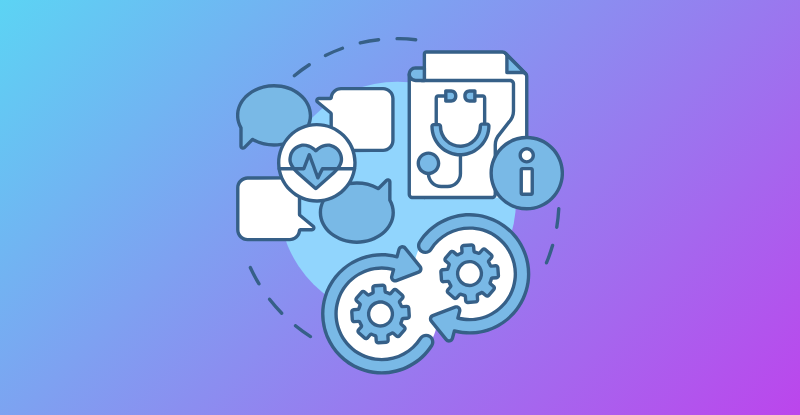What is interoperability applied to healthcare?
The interoperability in healthcare it is a fundamental concept that revolutionizes the way healthcare systems operate. But, what is healthcare interoperability? To understand it, it's essential to go back to the beginnings of this evolution. In the 1980s, healthcare systems interacted manually through users responsible for connecting systems, transferring data, and using manual tools such as spreadsheets. However, as medicine and digital technology advanced, the need for greater efficiency in communication and information exchange in the healthcare sector became evident.
In healthcare, interoperability is defined as the ability of various technologies, systems, and applications to exchange information efficiently and securely. Essentially, it is the key that opens the doors to more efficient and safer healthcare. In a broader sense, this concept of interoperability has been around for a long time but has evolved from manual system interaction to the integration of multiple platforms based on international standards. This evolution has been crucial for ensuring continuity of care and has led to significant improvements in the quality of care that patients receive.
How to achieve a fully interoperable healthcare system?
Building a fully interoperable healthcare system is an ambitious yet achievable goal. To achieve it, several key aspects must be addressed:
1. Standards and Protocols
The implementation of technical standards and interoperability protocols is an essential starting point. They ensure that information is shared consistently and securely across different healthcare systems. Among the most recognized standards are:
- DICOM (Digital Imaging and Communications in Medicine): This standard focuses on the management and transmission of medical images, such as X-rays, CT scans, and other types of medical images.
- HL7 (Health Level Seven): It is a set of international standards that facilitate the electronic exchange of clinical information among various healthcare providers. These standards establish the language, structure, and data types necessary for seamless integration between healthcare systems.
- FHIR (Fast Healthcare Interoperability Resources): FHIR is a modern and open standard developed by HL7 for health information exchange. It is web-based and allows the integration of different systems, regardless of how they store information.
2. Electronic Health Record (EHR) Systems
Electronic health record (EHR) systems play a fundamental role in achieving interoperability. These systems are responsible for storing patients' medical records and, to ensure interoperability, they must adhere to specific standards and be capable of securely sharing data with other healthcare systems. The adoption of interoperable EHRs is a crucial step toward a fully integrated healthcare system.
3. Policies and Regulations
To promote interoperability throughout the healthcare system, governments and health authorities must establish appropriate policies and regulations. These policies may include incentives for the adoption of interoperable technology and measures to protect patient data privacy. Collaboration among different stakeholders, such as hospitals, clinics, laboratories, and pharmacies, is essential to ensure a robust regulatory framework.
4. Training and Education
Training and education are essential to ensure that healthcare professionals are prepared to use interoperable systems and understand the importance of securely sharing data. Technological advancements demand continuous training so that medical and administrative staff can make the most of the available tools.
Levels of interoperability in Healthcare
Interoperability in healthcare is divided into several levels, each with its own characteristics and requirements. These types include:
1. Syntactic Interoperability
This level of interoperability refers to the systems' ability to exchange information and communicate using the same format and communication protocol. International standards have been developed to define how data should be structured and transmitted. Some notable syntactic standards include DICOM, HL7, and FHIR.
2. Semantic Interoperability
La interoperabilidad semántica se centra en la capacidad de los sistemas para comprender el significado de la información compartida. Esto implica que los sistemas deben compartir un vocabulario y una comprensión común de los términos utilizados en los datos clínicos. Para lograr esto, se utilizan codificaciones internacionales, como SNOMED, LOINC y CIE, que permiten que todas las organizaciones «hablen el mismo idioma» en términos de terminología médica.
3. Organizational Interoperability
Organizational interoperability refers to the systems' ability to work in a coordinated manner, sharing responsibilities and authorities. At this level, business rules are defined, determining what information will be exchanged and what actions will trigger such exchanges. Organizational interoperability is crucial to ensure that healthcare systems can collaborate effectively.
What Benefits Does Interoperability Offer in Healthcare?
The benefits of interoperability in healthcare are extensive and significant, both for patients and healthcare professionals, as well as the healthcare systems in general. Some of the highlighted benefits include:
1. Improved Patient Care
Interoperability enables quick and accurate access to patient information, resulting in more precise and timely care. Physicians can make informed decisions based on a complete patient history, significantly improving the quality of care.
2. Reduction of Medical Errors
Effective communication between different healthcare systems reduces the likelihood of medical errors, such as prescribing incorrect medications or duplicating tests. This enhances patient safety and prevents unnecessary complications.
3. Efficiency in Data Management
Interoperability simplifies the management of clinical data, reducing the time and resources needed to access and share information. This saves time for both healthcare professionals and patients.
4. Continuity of Care
The ability to share information effectively among different healthcare providers ensures optimal continuity of care. Patients can receive continuous and coordinated care, even if they visit different healthcare institutions.
5. Research and Data Analysis
Interoperability in healthcare also benefits medical research and data analysis. The availability of large clinical data sets facilitates medical research, potentially leading to advances in disease treatment and overall health improvement.
What Will the Healthcare System of the Future Look Like?

The future of the healthcare system is shaping up as a highly interconnected ecosystem, where interoperability will play a central role. Healthcare systems of the future will be fully integrated, allowing a seamless flow of information among hospitals, clinics, laboratories, and other healthcare providers. Here are some predictions about what the healthcare system of the future will look like:
1. Advanced Telemedicine
Telemedicine will expand further, enabling virtual medical consultations, remote patient monitoring, and access to quality healthcare from any location. Interoperability will ensure that patient data is available to healthcare providers, regardless of their location.
2. Artificial Intelligence and Data Analytics
Artificial intelligence and data analytics will play a crucial role in disease diagnosis and treatment. Healthcare systems will use advanced algorithms to analyze large clinical data sets and identify patterns and trends that may go unnoticed by physicians.
3. Personalized Health Record
Each patient will have access to their personalized electronic health record, containing detailed information about their medical history, test results, treatments, and recommendations. Patients will be able to share their record with healthcare providers as needed, facilitating personalized care.
4. Increased Patient Engagement
Patients will play a more active role in their healthcare. They will have access to their health data, be able to track their progress, and make informed decisions about their care. Interoperability will ensure that this information is easily accessible to patients.
In summary, interoperability in healthcare is a transformative trend that is shaping the future of healthcare. It enables more precise, secure, and efficient care and offers significant benefits to patients, healthcare professionals, and medical research. The healthcare system of the future will be a highly interconnected ecosystem, where information flows seamlessly, improving the quality of care and people's lives. Interoperability is the path to a healthier and more promising future.
For over a decade, at K2BHealth, we have been assisting healthcare organizations in designing and implementing interoperability platforms. Our goal is to transform the connectivity capabilities of these organizations, following the most advanced international standards. Learn more about our interoperability platform.

